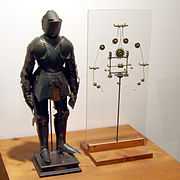Leonardo's robot or Leonardo's mechanical knight refers to a humanoid automaton designed by Leonardo da Vinci around the year 1495.[1]
The design notes for the robot appear in sketchbooks that were rediscovered in the 1950s.[1] Leonardo displayed his "robot" at a celebration hosted by Ludovico Sforza at the court of Milan in 1495. The robot knight could stand, sit, raise its visor and independently maneuver its arms. The entire robotic system was operated by a series of pulleys and cables. Since the discovery of the sketchbook, the robot has been built faithfully based on Leonardo's design; this proved it was fully functional, as Leonardo had planned.[2]
The robot is clad in German-Italian medieval armour, that is able to make several human-like motions. These motions included sitting up, moving its arms, neck, and an anatomically correct jaw. Also it was most likely planned to be made with fluidity in combat. It is partially the fruit of Leonardo's anatomical research in the Canon of Proportions as described in the Vitruvian Man.
| Model of Leonardo's robot with inner workings, as displayed in Berlin |
| Building the robot of Leonardo da Vinci in the Leonardo3 laboratories by Mario Taddei. |
|
Notes
- ↑ 1.0 1.1 The da Vinci robot. Retrieved 2013-10-29. "... the date of the design and possible construction of this robot was 1495 ... Beginning in the 1950s, investigators at the University of California began to ponder the significance of some of da Vinci's markings on what appeared to be technical drawings ... It is now known that da Vinci's robot would have had the outer appearance of a Germanic knight."
- ↑ Rosheim; Mark Elling. Leonardo's Lost Robots. Springer, 2006, p. 69.
|
|---|
| | | | Paintings | |
|---|
| | Sculptures | |
|---|
| | Works on paper | |
|---|
| | Manuscripts | |
|---|
| | Other projects | |
|---|
| | Leonardeschi | |
|---|
| | Posthumous fame | |
|---|
| | Wikimedia | |
|---|
|
- Key: *Attributed
- **Collaboration with other artists
- †Lost
|
|
|
|---|
| | Legged |
Mini | |
|---|
| Small / medium | |
|---|
| Human-sized | |
|---|
| Big | |
|---|
|
|---|
| | Wheeled | |
|---|
| | With tracks | |
|---|
| | Upper torso | |
|---|
| |
|

